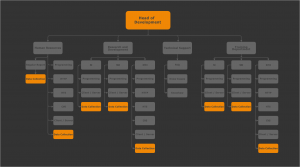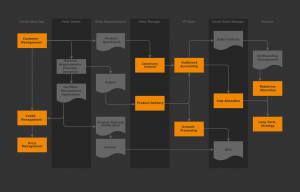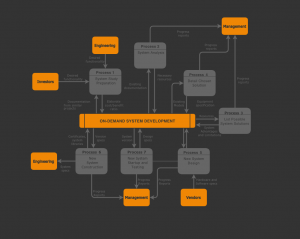Onboarding, also referred to as induction, is a tough challenge, both for companies and for new employees. Faced with either providing or needing to quickly understand a mountain of information on a wide variety of topics, it’s easy to feel overwhelmed on both sides of the fence.
Staff turnover rates in many companies are increasing, as shown in Mercer’s 2014 report on employment trends around the world. HR departments have increasingly more work to do, but at the same time they are under pressure to reduce administrative costs. And of course, new hires are pushed to get up to speed faster.
Better onboarding processes lead to many different positive outcomes – higher job satisfaction, better performance, stronger commitment, lower stress, and longer job retention. Keeping staff happy can provide a company with a substantial advantage over their competition.
Why diagrams?
The majority of us are visual learners, and diagrams make conveying complex information easier and faster. Plus, we remember information presented in diagrams better.
It makes sense that diagrams can make the onboarding process much simpler, more efficient, and more enjoyable for everyone.
But, it is most important to keep all documents, diagrams, and forms in the one place. Confluence and its draw.io add-on make it easy to organize information and let everyone create useful diagrams.
Common diagrams already in use
There are many processes and structures that new staff come across during onboarding, that would be clearer when represented in a diagram. Let’s start with the most obvious cases.
Organization charts: One of the most obvious diagrams shows the company’s hierarchy and departmental organization. You can also create an organization graph – it is better for representing project teams and cross-departmental working groups.
Office or building maps: Don’t let new hires get lost on their first day – provide them with a map. This is also useful for visitors attending meetings or events, and especially important for larger companies.
Business processes: Create diagrams for business processes with links to people who need to approve steps, or links to forms that need to be filled out. Annual leave applications, reimbursement requests, even IT troubleshooting tasks can be represented with procedural diagrams.
Improved onboarding diagrams
It isn’t particularly groundbreaking to represent the above information with diagrams – most companies are already doing this, to some extent. But there are many more useful diagrams that could make the onboarding process much smoother.
Represent the onboarding process
Represent the entire process in a diagram. draw.io makes it easy to add links in a diagram to people and information within a company’s intranet, so a new employee will never feel lost, and will always know who to ask about any stage of the process. Bonus points for sending this to them before their first day! A Gantt chart can help your new colleague (and their supervisors or mentors) know whether they are on track or falling behind.
Use an infographic to explain the company’s history, products and values
Instead of reading pages of boring written information about the history of the company, its values or products, make it easy to remember by putting it into an attractive infographic.
Show their roles and responsibilities
You can create a mind-map style diagram centered on the new employee – include the various responsibilities and roles they are expected to fulfill, and the tasks they will complete in each of these. Providing role clarity leads to improved productivity and self-sufficiency, and contribute to job satisfaction.
Illustrate the intranet or the company wiki
Company intranets are daunting repositories of information for most new hires – where is the information they want to find ‘hidden’? Make it easier by using a mind map or tree to show the logical structure of your intranet – which locations contain which topics – and link to the important landing pages. Creating this diagram will prompt you clean out some of the intranet debris that always exists. Do you use shared drives for project work or in departments? Make a diagram!
Detail teams and team responsibilities
If your company has a number of projects or teams, create a diagram and include their responsibilities. This makes it easier for new colleagues to find the right person to ask when they have questions or problems.
Use flow charts for common problems or tasks
A simple example: If you have a problem with a printer, turn it off, then turn it on, if it doesn’t work – contact this person. Make sure you link to appropriate people and documents within your company’s intranet so the employee can help themselves! IT problems, vacation planning, steps in the consulting process, what do to with a customer complaint – almost any scenario and process can be simply represented by a workflow or interaction diagram.
Provide overviews of software diagrams
If you are developing software, you must be familiar with some of the common diagram types: Class diagrams, data flow diagrams, use case diagrams, entity relationship models, and many others are used throughout the development process. For new staff, higher level overview diagrams are useful – and they can be linked to the more detailed and specific diagrams used during projects.
What other diagrams would be useful?
Think back to when you started your last job. What information would have been easier in diagram form? Which diagrams did you appreciate the most?
We’d love to know what you think!
If you are excited to improve your company’s onboarding process by creating some (or all) of the diagrams above – we can help you get started with draw.io. Keep these beginner cheat sheets by your side – they will help you work more efficiently with draw.io. Our draw.io portal has user documentation, demonstration videos and example diagrams that may also come in handy.
Learning management in Confluence with diagrams, courses and quizzes
Stiltsoft provides a great app that supports onboarding in Confluence – you can develop and deliver courses and test your employees’ knowledge as they progress through their training. draw.io diagrams can be embedded in SiltSofts’ Courses and Quizzes – LMS app for Confluence, making it even easier to onboard new users in your Confluence instance.
Last Updated on April 17, 2020 by Admin







